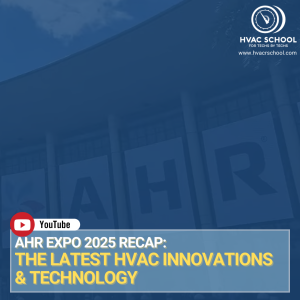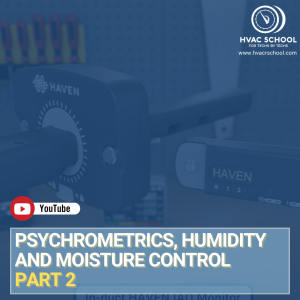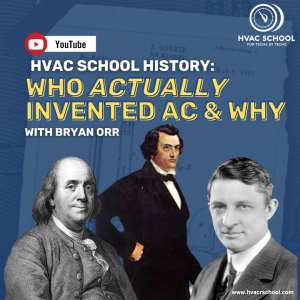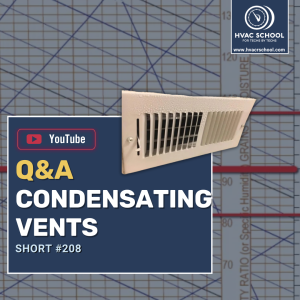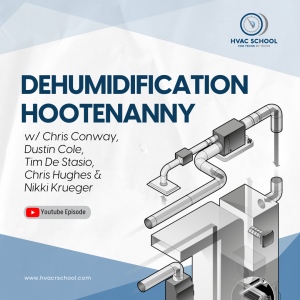BACK
 Traditional & Desiccant Dehumidification and When to Use Each (or Both)
Traditional & Desiccant Dehumidification and When to Use Each (or Both)
 Dedicated Dehumidifier vs. Electric Reheat Dehumidification – Who Ya Got?
Dedicated Dehumidifier vs. Electric Reheat Dehumidification – Who Ya Got?
 The Best (and Worst) Ways To Duct a Dehumidifier
The Best (and Worst) Ways To Duct a Dehumidifier
 Short Cycling
Short Cycling
 How to Properly Size a Dehumidifier
How to Properly Size a Dehumidifier
 Solving Comfort and IAQ Issues in a Vintage Home: A Case Study
Solving Comfort and IAQ Issues in a Vintage Home: A Case Study
 Improving Humidity Control on the Cheap
Improving Humidity Control on the Cheap
 The Strange Behavior of Moisture in Stuff
The Strange Behavior of Moisture in Stuff
 Something to Watch For When Replacing a Thermostat
Something to Watch For When Replacing a Thermostat
 Cold Coil vs. Desiccant Dehumidification
Cold Coil vs. Desiccant Dehumidification
 Oversized Evap Coils? – Short #237
Oversized Evap Coils? – Short #237
 Santa Fe Talks Dehumidification at AHR 2025
Santa Fe Talks Dehumidification at AHR 2025
 Q&A – System Won’t Dehumidify? – Short #214
Q&A – System Won’t Dehumidify? – Short #214
 Q&A – How to Deploy a Dehum – Short #211
Q&A – How to Deploy a Dehum – Short #211
 Q&A – Condensating Vents – Short #208
Q&A – Condensating Vents – Short #208
 Q&A – Testing Dehumidifiers – Short #206
Q&A – Testing Dehumidifiers – Short #206
 How to Size Dehums w/ Tim De Stasio
How to Size Dehums w/ Tim De Stasio
 An IAQ & Dehum Case Study w/ Genry & Nikki
An IAQ & Dehum Case Study w/ Genry & Nikki
 Home Performance Panel
Home Performance Panel
 Dehumidification Hootenanny
Dehumidification Hootenanny
#dehumidification
Tech Tips:

This tech tip is based on a conversation with Nikki Krueger and David Schurk. Nikki is a longtime contributor to HVAC School and is a relatively frequent podcast guest and symposium speaker. David Schurk is the Director of Applied Engineering and National Sales Manager at Innovative Air Technologies. Nikki specializes in traditional cold-coil dehumidifiers, and […]
Read more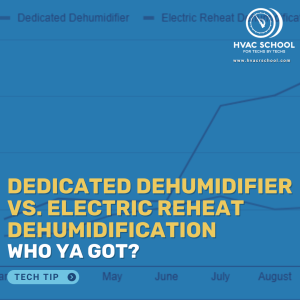
This tech tip was written by Tim De Stasio. He originally published it on his website, which you can visit HERE. Thanks, Tim! In March of 2024, I set out to better understand the cost of ownership and return on investment for two dehumidification strategies: a dedicated dehumidifier versus using electric reheat dehumidification from my […]
Read more
There are a couple of really important things to understand when ducting a dehumidifier. Getting one or both of these things wrong can throw off your entire dehumidifier install. Instead of just telling you the different ways you can install a dehumidifier, let’s talk through some dehumidifier basics, which will help us understand why it’s […]
Read more
A friend of mine was telling me that a utility had the idea that they could reduce energy consumption by turning HVAC equipment on and off rapidly during times of high load. In their minds, wouldn't it be better to spread out the off time rather than keeping the system off for longer periods and […]
Read more
This tech tip was submitted to us by Tim De Stasio. You can read the original version on his website HERE. Tim will also be a panelist in the Dehumidification Hootenanny at the 2024 HVACR Training Symposium. Nikki Krueger will moderate, and Genry Garcia, Chris Hughes, and Chris Conway will be fellow panelists. If you’ve […]
Read more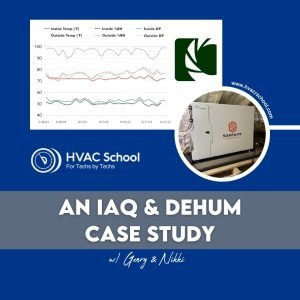
This tech tip is a recap of the Santa Fe Dehumidifiers and Comfort Dynamics, Inc. case study about a 1941 vintage home in Miami, FL. You can listen to the podcast about that case study by clicking the play button below, and you can read the case study at https://hvacrschool.com/case-study. Special thanks to Nikki Krueger […]
Read more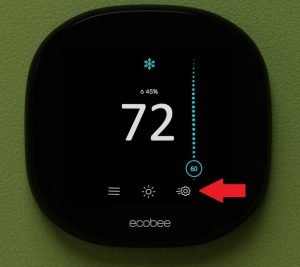
This tech tip was submitted by Steve Rogers, the current president of The Energy Conservatory (TEC). Steve has been on the podcast several times in the past and is a valued contributor to HVAC School. Thanks, Steve! As summer approaches, HVAC technicians all over the US are preparing for those difficult conversations with occupants about […]
Read more
Water is weird and water vapor is even weirder – before we dive down this rabbit hole lets define some terms To better understand the behavior of moisture in materials, we need to first define some essential terms and concepts: Relative Humidity (RH): The ratio of the amount of water vapor in the air to […]
Read more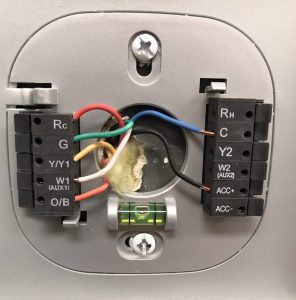
Sometimes, you may have to replace a fancy thermostat with a simple one. It may be because the customer got fed up with all the options, or maybe the basic stat is the only thing on your truck. No matter the reason, you need to make sure the new thermostat can do the old one's […]
Read moreVideos:
Podcasts:

In this comprehensive episode of the HVAC podcast, Bryan hosts an in-depth discussion about dehumidification technologies with two industry experts: David Schurk, National Sales Manager for Innovative Air Technologies, and Nikki Krueger from Santa Fe Products. The conversation explores the fundamental differences between compression refrigeration dehumidification and solid desiccant systems, providing valuable insights for […]
Read more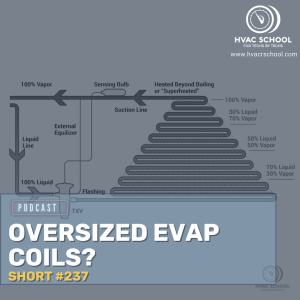
In this short podcast episode, Bryan answers a listener-submitted question about oversized evaporator coils, particularly when they're half a ton or a full ton larger than the condenser. The expanded performance data contains the information that'll tell you whether the coil is right for the system. However, when it comes to the specific issue […]
Read more
In this insightful discussion at AHR 2025 in Orlando, Bryan connects with Nikki Krueger from Santa Fe dehumidifiers, exploring the evolution and importance of whole-house dehumidification in modern HVAC systems. Nikki, who has spent 20 years in the indoor air quality industry, shares her journey from a public relations background to becoming deeply involved […]
Read more
In this short podcast episode, Bryan answers a listener-submitted question about an HVAC system that won't dehumidify. This question was submitted by a homeowner with a Carrier heat pump with an attic air handler that cools but won't dehumidify on the hottest days of summer. One of the past companies that serviced the system […]
Read more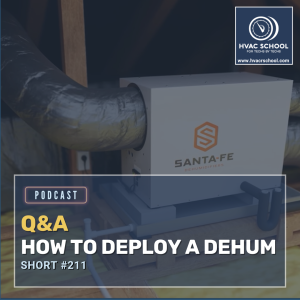
In this short Q&A podcast episode, Bryan answers Howard's question about how to deploy a dehumidifier (dehum) in a sealed home. He addresses things like location and fresh air requirements in green-grass markets with high dew points. Before deploying a dehumidifier, you will need to know about the climate, the structure, and the client's […]
Read more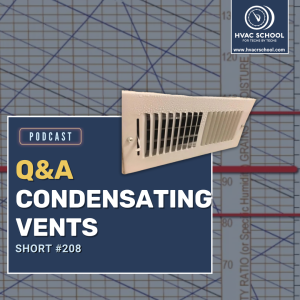
In this short Q&A podcast episode, Bryan answers Kenton's question about how to stop vents from condensating, especially when sealing and insulation don't do the trick. When approaching a condensation problem, we have to consider the source of moisture and where the condensation is happening. Moisture that builds up on top of the vent […]
Read more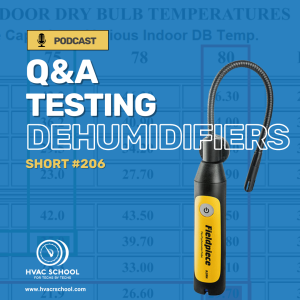
In this short podcast episode of the Q&A series, Bryan answers a question about testing dehumidifiers (submitted by Steven via Speakpipe). Dehumidifiers run air over a cold evaporator coil (to pull moisture out of the air and drain it out) and then reheat it over a condenser coil. The air leaving a dehumidifier is of […]
Read more
In this episode of the HVAC School podcast, host Bryan Orr interviews Tim De Stasio, an experienced HVAC practitioner and consultant. Tim shares his journey in the HVAC industry, from his early days in vocational school to running his own contracting business for 12 years. He now focuses on consulting, design, and contractor training, […]
Read more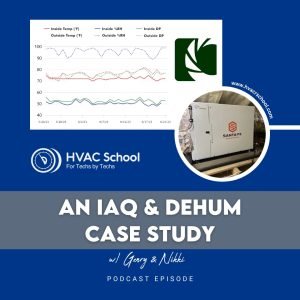
Nikki Krueger and Genry Garcia return to the podcast to talk about a recent IAQ & dehumidification case study on a vintage home in Miami. The home was very clean but had a musty odor and VOC concerns. You can read the case study in the “Literature” section at https://www.santa-fe-products.com/about-us/media-resources/. Blower door tests and ZPD […]
Read moreEvents:

NOTE: If you cannot view the recording, the video may still be processing. The maximum wait time is 24 hours. We apologize for the delay and appreciate your patience.
Read more
NOTE: If you cannot view the recording, the video may still be processing. The maximum wait time is 24 hours. We apologize for the delay and appreciate your patience.
Read more
